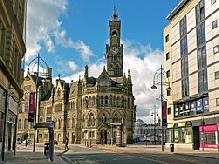
Legal © Maurice Claypole 2012
The City of Bradford, Yorkshire, UK, was once the centre of the world’s wool trade.
My home town
Although I was born in nearby Halifax, my parents decided to move to Bradford sometime
before my fourth birthday. Throughout the nineteen-
In addition to the innovators of the industrial revolution such as Samuel Lister and Titus Salt (the village of Saltaire, founded to house his workers is now a UNESCO World Heritage site), Morrison’s supermarket chain has its origins in Bradford, having been founded by William Morrison in 1899, then trading as an egg and butter merchant.
However, unemployment remains high and like many other mixed communities, Bradford has experienced its share of social and ethnic tension. On the other hand, the city is also famous for its annual multicultural festival (the ‘Bradford Mela’), whilst the predominance of cuisine from the Indian subcontinent has earned it the sobriquet of the ‘Curry Capital of Britain’.
Notable Bradfordians include artist David Hockney, composer Frederick Delius (another childhood memory of mine is of watching his family’s wool warehouse burn down in the Great Fire of Bradford), novelist and playwright J. B. Priestley and social reformer Richard Oastler.

“At the turn of the 19th century, Bradford was a small rural market town of 16,000 people, where wool spinning and cloth weaving was carried out in local cottages and farms. The Industrial Revolution led to rapid growth, with wool imported in vast quantities for the manufacture of worsted cloth in which Bradford specialised, and the town soon became known as the wool capital of the world.
By 1850 the population had reached 182,000 as workers were attracted by jobs in the textile mills.”
-